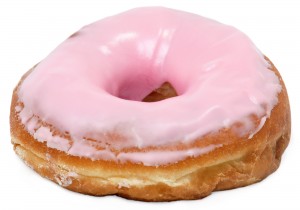One popular dieting trick is to quantify how much activity is required to burn off certain foods.Most people underestimate (or don’t even know) the amount of calories in their food, and overestimate their activity level. People assume they expend far more energy than they actually do while exercising. And to top it off, people treat all calories equally, without taking into account the effect on metabolism that refined carbohydrates and added sugar have. All this adds up to weight gain.
This article describes a study that seeks to determine whether people make different food choices if the caloric expenditure is placed directly on the label. Would we choose a small, glazed donut (200 calories= 2 miles of running) over the creme-filled eclair (400 calories=4 miles of running) if we knew we would have to run the extra miles to burn off the eclair? If we knew that we would have to run the NYC Marathon to eat certain foods, would that make a difference?
The rationale behind an experiment like this is to give people a realistic idea of how much it actually takes to burn off the foods in our diet, particularly junk foods. It allows for a brief pause in which a person can make a decision, rather than act on impulse.
Processed foods and restaurant foods far surpass what an average person needs to maintain their weight, and are often engineered to make people over-consume. Once eaten, certain processed foods deliberately over-ride the body’s signals of satiety, and would thus also over-ride any calorie labels. We could definitely use a “pause button” in front of us at the point of purchase, prior to eating. However, even if we choose the lower calorie option, the 200 calories in a glazed donut are processed much differently by the body than 200 calories in an apple and some mixed nuts. Simple calorie counts do not factor this in and can be misleading.
While an effort like this is a great idea to educate people about calories and activity, and aid in decision-making, I’m not sure this type of thinking should be a permanent part of an overall Mindful Life. I see it as a beginning phase—like training wheels of food and exercise habits—to be discarded when it is no longer useful.
I fear that adopting this mindset moves food and exercise into the arena of rewards/punishments, “points,” “good and bad,” and lays the foundation for an unhappy relationship between food and activity. It is more sustainable and satisfying to use self-compassion and self-care when making food choices. See my post about the neuroscience of habits, and how the mindful pause can help.


I agree with the philosophy but I also like your spin on associating food with negative consequences like having to exercise harder or longer. How do you feel about food being a reward to flip it around for good activity. I know when I am training hard I look forward to my weekly cheat meal and that keeps me from making poor choices throughout the week because I have something to look forward to.
That is a great idea Paul–flipping the mentality is very helpful. I do that also as a way of rewarding myself, and having something to look forward to. Thanks for the input!
I agree with Paul. I like to put a positive spin on dieting. If I bombard myself with too many negatives – such as worrying about every calorie and how much it will take to burn it off, I don’t enjoy eating anymore. I’m not saying that we should stick our heads in the sand and refuse to think about calories – everyone should know what they’re eating and the effect it has on their body. But I don’t like the idea of every label telling me how much it’s going to cost me in miles. Back to the positives, I go to the gym so I can eat what I want – within reason of course.